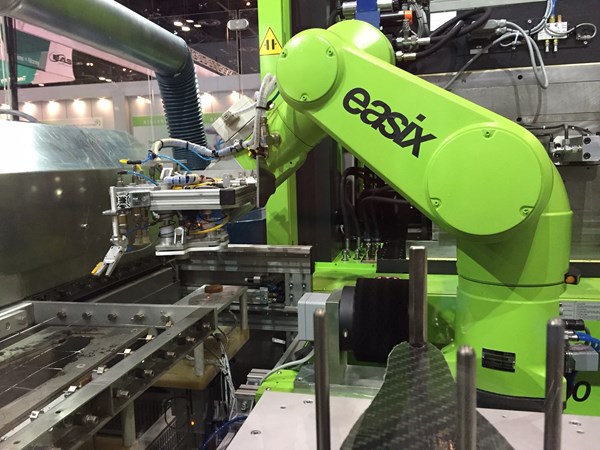Thermoplastic composites feel the love at NPE2015
At NPE2015, some of the key players involved in thermoplastic composites exhibited a variety of solutions that are leading growth in new and emerging markets.

Engel's concept for manufacturing a hybrid, brake pedal from thermoplastic fabric was on display at NPE2015.
Plastics recently saw its day in the sun during NPE2015 (March 23-27; Orlando, FL, US), the international plastics trade show that is held every three years. Some of the key players involved in thermoplastic composites exhibited a variety of solutions that are leading growth in new and emerging markets. Highlights included:
KraussMaffei demonstrated its FiberForm process that produced airbag housings made of fiberglass-reinforced polyamide with a shot weight of 350g in cycle times of 45 seconds. The FiberForm process developed by KraussMaffei combines injection molding with thermoforming of composite sheets to reportedly further improve the strength of fiber-reinforced plastics.
Lanxess presented a variety of exhibits featuring Durethan polyamides, Pocan polybutylene terephthalates (PBTs) and Tepex continuous fiber-reinforced composites in lightweight automotive applications. One key highlight was a hybrid design infotainment carrier made from a continuous fiber-reinforced polyamide composite and a polyamide 6 overmolding material that is being used for the first time in the Audi A6.
The American Composites Manufacturers Association (ACMA, Arlington, VA, US) sponsored the Composites Pavilion on the trade show floor as well as a half day of specialized technical education on the hot topic of thermoplastics to the Business of Plastics Track at NPE.
CW caught up with injection molding producer Engel during NPE to talk all things composites. In the next few years, the company foresees strong growth in the injection molding industry, particularly in the field of fiber composite engineering.
“Composites continue to become more and more popular,” Sebastian Picheta, who is responsible for Engel’s development of automation and handling solutions for composites, told CW. “There are so many new challenges to solve and that’s why we created our technology center.”
Engel established a technology center for lightweight composites in 2012 at the site of its machine production facility in St. Valentin, Austria. The technology center was created primarily as a platform for interdisciplinary collaboration with international partner enterprises and universities.
In fact, at NPE, Engel showcased one of the “milestones” that was achieved at the facility: a stress-resistant plastic brake pedal. The concept for manufacturing a hybrid brake pedal from thermoplastic fabric received the Composite Innovations Award in 2011, and has been consistently enhanced by Engel’s partner ZF-Friedrichshafen since then.
Using a vertical Engel insert 1050H/230 single injection molding machine with an Engel easix multi-axis industrial robot and infrared oven, a continuous-fiber-reinforced preconsolidated thermoplastic sheet was heated, preformed in a mold and immediately overmolded with polyamide. The system produces ready-to-fit components and no trimming is necessary, according to the company.
In addition, the product developers at ZF adapted the layer structure to the component load when designing the brake pedal. This enabled the component weight to be reduced by around 30% compared to conventional steel brake pedals—without impairing load-bearing capacity.
Engel says the control unit of the easix multi-axis robot is fully integrated into the control unit of the injection molding machine. As a result, besides making it easy to operate and program the robot, the movements of the machine and robot are coordinated with each other. Since the robot has access to the machine parameters, the gripper can enter the mold area during the opening movement, which in turn reportedly significantly reduces cycle times.
Automation is the key for composite materials to find even wider use in high-volume applications, such as in the automotive sector. Picheta said that at its technical center, the company is constantly looking at ways to develop manufacturing processes that produce high-volume parts but with low unit costs.
“Automation is not easy and new development is needed as there is more demand out there for mass production and to have fully automated cells,” Picheta said. “Automation will be a big part of the future.”
Read Next
Developing bonded composite repair for ships, offshore units
Bureau Veritas and industry partners issue guidelines and pave the way for certification via StrengthBond Offshore project.
Read MorePlant tour: Daher Shap’in TechCenter and composites production plant, Saint-Aignan-de-Grandlieu, France
Co-located R&D and production advance OOA thermosets, thermoplastics, welding, recycling and digital technologies for faster processing and certification of lighter, more sustainable composites.
Read More“Structured air” TPS safeguards composite structures
Powered by an 85% air/15% pure polyimide aerogel, Blueshift’s novel material system protects structures during transient thermal events from -200°C to beyond 2400°C for rockets, battery boxes and more.
Read More

















